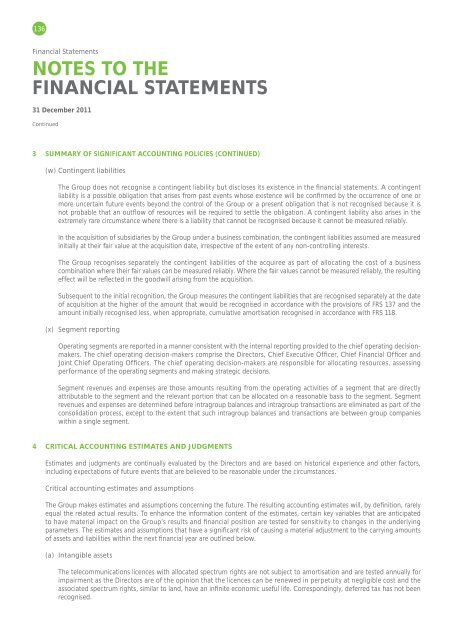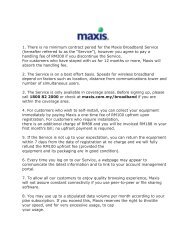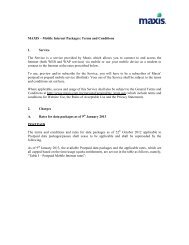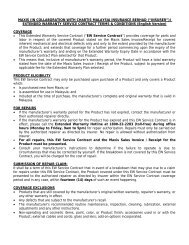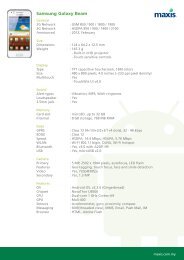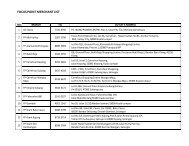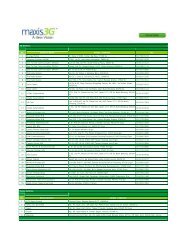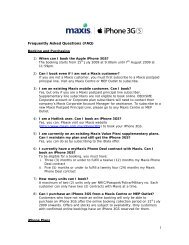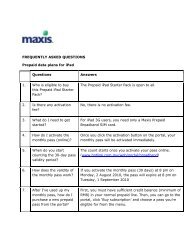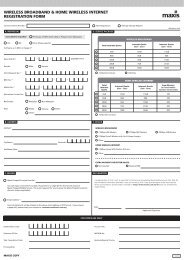ENRICHING LIVES EXPANDING HORIZONS - Maxis
ENRICHING LIVES EXPANDING HORIZONS - Maxis
ENRICHING LIVES EXPANDING HORIZONS - Maxis
You also want an ePaper? Increase the reach of your titles
YUMPU automatically turns print PDFs into web optimized ePapers that Google loves.
136<br />
Financial Statements<br />
NOTES TO THE<br />
FINANCIAL STATEMENTS<br />
31 December 2011<br />
Continued<br />
3 SUMMARY OF SIGNIFICANT ACCOUNTING POLICIES (CONTINUED)<br />
(w) Contingent liabilities<br />
The Group does not recognise a contingent liability but discloses its existence in the financial statements. A contingent<br />
liability is a possible obligation that arises from past events whose existence will be confirmed by the occurrence of one or<br />
more uncertain future events beyond the control of the Group or a present obligation that is not recognised because it is<br />
not probable that an outflow of resources will be required to settle the obligation. A contingent liability also arises in the<br />
extremely rare circumstance where there is a liability that cannot be recognised because it cannot be measured reliably.<br />
In the acquisition of subsidiaries by the Group under a business combination, the contingent liabilities assumed are measured<br />
initially at their fair value at the acquisition date, irrespective of the extent of any non-controlling interests.<br />
The Group recognises separately the contingent liabilities of the acquiree as part of allocating the cost of a business<br />
combination where their fair values can be measured reliably. Where the fair values cannot be measured reliably, the resulting<br />
effect will be reflected in the goodwill arising from the acquisition.<br />
Subsequent to the initial recognition, the Group measures the contingent liabilities that are recognised separately at the date<br />
of acquisition at the higher of the amount that would be recognised in accordance with the provisions of FRS 137 and the<br />
amount initially recognised less, when appropriate, cumulative amortisation recognised in accordance with FRS 118.<br />
(x) Segment reporting<br />
Operating segments are reported in a manner consistent with the internal reporting provided to the chief operating decisionmakers.<br />
The chief operating decision-makers comprise the Directors, Chief Executive Officer, Chief Financial Officer and<br />
Joint Chief Operating Officers. The chief operating decision-makers are responsible for allocating resources, assessing<br />
performance of the operating segments and making strategic decisions.<br />
Segment revenues and expenses are those amounts resulting from the operating activities of a segment that are directly<br />
attributable to the segment and the relevant portion that can be allocated on a reasonable basis to the segment. Segment<br />
revenues and expenses are determined before intragroup balances and intragroup transactions are eliminated as part of the<br />
consolidation process, except to the extent that such intragroup balances and transactions are between group companies<br />
within a single segment.<br />
4 CRITICAL ACCOUNTING ESTIMATES AND JUDGMENTS<br />
Estimates and judgments are continually evaluated by the Directors and are based on historical experience and other factors,<br />
including expectations of future events that are believed to be reasonable under the circumstances.<br />
Critical accounting estimates and assumptions<br />
The Group makes estimates and assumptions concerning the future. The resulting accounting estimates will, by definition, rarely<br />
equal the related actual results. To enhance the information content of the estimates, certain key variables that are anticipated<br />
to have material impact on the Group’s results and financial position are tested for sensitivity to changes in the underlying<br />
parameters. The estimates and assumptions that have a significant risk of causing a material adjustment to the carrying amounts<br />
of assets and liabilities within the next financial year are outlined below.<br />
(a) Intangible assets<br />
The telecommunications licences with allocated spectrum rights are not subject to amortisation and are tested annually for<br />
impairment as the Directors are of the opinion that the licences can be renewed in perpetuity at negligible cost and the<br />
associated spectrum rights, similar to land, have an infinite economic useful life. Correspondingly, deferred tax has not been<br />
recognised.


